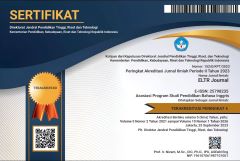APPLYING POSITIVE REINFORCEMENT TO INCREASE STUDENTS’ MOTIVATION IN LEARNING ENGLISH FOR GRADE VII IN SMP PANGUDI LUHUR 1 YOGYAKARTA
Abstrak terlihat: 1012 / PDF terunduh: 592DOI:
https://doi.org/10.37147/eltr.v2i1.92Keywords:
Positive reinforcement, motivation, classroom action researchAbstract
This research aims to find out how the positive reinforcement is given to motivate the seventh grade students in SMP Pangudi Luhur 1 Yogyakarta and to explain the benefits of applying positive reinforcement. In order to answer the two research problems; how is positive reinforcement given to motivate the students in SMP Pangudi Luhur 1 Yogyakarta and what are the benefits of applying positive reinforcement in SMP Pangudi Luhur 1 Yogyakarta, the researcher used mixed-method for this research. The researcher used three theories in order to answer the first and second research problems. For the first problem, the researcher used the theory from Becker, Engelman, and Thomas (1975) which explained about the ways of apply positive reinforcement.Meanwhile, the theories from Al-Tamimi and Shuib (2009) and Maehr (1984) which defined about the benefits of applying positive reinforcement were used to answer the second research problem. Those threetheories used as the foundation in making observation checklist and questionnaire. The researcher applied Classroom Action Research (CAR) for this research. The research showed that applying positive reinforcement in the form of giving praise and extra score was used by English tutor to motivate the students in learning English.
Downloads
References
Al-Tamimi, A., & Shuib, M. (2009). Motivation and attitudes towards learning english: a study of petroleum engineering undergraduates at hadhramout university of science and technology. GEMA Online Journal of Language Studies, 9(2). Retrieved on June 9, 2017, from www.ejournal.ukm.my/gema/article/view/156.pdf
Ary, D., Jacobs, L. C., & Razavieh, A. (2002). Introduction to research in education (6thed.). Belmont, CA: Wadsworth/Thompson Learning.
Broussard, S. C., & Garrison, M. E. B. (2004). The relationship between classroom motivation and academic achievement in elementary school-aged children. Family and Consumer Sciences Research Journal, 33(2), 106-120.
Burgess, M. (2015). Promise theory and how to apply it to systems. Oxford: Design and Patents Act.
Burns, A. (1999). Collaborative action research for English language teacher. Cambrige: Cambridge University Press.
Deakin University. (1982). The action research reader. Geelong: Deakin University Press.
Kemmis, S., & McTaggart, R. (1988). The action research planner (3rd ed.). Geelong: Deakin University Press.
Maehr, M. (1984). Meaning and motivation: Toward a theory of personal investment. In R. Ames and C. Ames (Ed.), Research on motivation ineducation (pp. 115-144). Orlando, FL: Academic Press.
McLeod, S. A. (2007). Stages of memory – encoding storage and retrieval. Retrived on March 20, 2018, from http://www.simplypsychology.org/edward-thorndike.html
Meizi, M. N. (2015). Indonesians’ problems in learning English. Retrieved on November 10, 2017, from http://www.linkedin.com
Mills, G. E. (2009). Action research: A guide for the teacher researcher (4th ed., pp. 5). Eugene, OR: Pearson.
Miltenberger, R. (2008). Behaviour modification. Belmont, CA: Wadsworth Publishing.
Pintrich, P. R. (2003). A motivational science perspective on the role of student motivation in learning and teaching contexts. Journal of Educational Psychology, 95(4), 667-686.
Shanks, N. H. (2012).Management and motivation. In Southwest airlines employee motivation: Good leadership skills (chap. 2).Retrieved on February 25, 2018, from http://www.skills2lead.com/southwest-airlines-employee-motivation.html
Simmons, K. & DiStasi, A. (2008). Active learning techniques: Engaging students on the road to success. Athletic Therapy Today, 13(6), 6-8.
Skinner, B. F. (1938). The behavior of organisms: An experimental analysis. New York: Appleton Century.
Slavin, R. E. (1991). Educational psychology: Theory into practice (3rd ed.). Belmont, CA: Allyn & Bacon.
Stipek, D. (1993). Motivation to learn: From theory to practice (2nd ed). Needham Heights. MA: Allyn & Bacon.
Thorndike, E. L. (1898). Animal intelligence: An experimental study of the associative processes in animals. Psychological Monographs: General and Applied, 2(4), i-109.
W. C. Becker, S. Engelmann, & D. R. Thomas (1975). Teaching 1: Classroom management. Journal of Applied Behavior Analysis, 5, 5- 95.
Downloads
Published
How to Cite
Issue
Section
License
Copyright (c) 2018 Emmelia Dyah, Patricia Angelina

This work is licensed under a Creative Commons Attribution-ShareAlike 4.0 International License.













